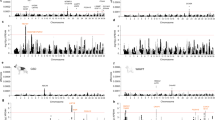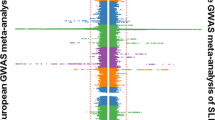Abstract
The unique canine breed structure makes dogs an excellent model for studying genetic diseases. Within a dog breed, linkage disequilibrium is extensive1,2, enabling genome-wide association (GWA) with only around 15,000 SNPs and fewer individuals than in human studies1,3. Incidences of specific diseases are elevated in different breeds, indicating that a few genetic risk factors might have accumulated through drift or selective breeding. In this study, a GWA study with 81 affected dogs (cases) and 57 controls from the Nova Scotia duck tolling retriever breed identified five loci associated with a canine systemic lupus erythematosus (SLE)–related disease complex that includes both antinuclear antibody (ANA)–positive immune-mediated rheumatic disease (IMRD) and steroid-responsive meningitis-arteritis (SRMA). Fine mapping with twice as many dogs validated these loci. Our results indicate that the homogeneity of strong genetic risk factors within dog breeds allows multigenic disorders to be mapped with fewer than 100 cases and 100 controls, making dogs an excellent model in which to identify pathways involved in human complex diseases.
This is a preview of subscription content, access via your institution
Access options
Subscribe to this journal
Receive 12 print issues and online access
$209.00 per year
only $17.42 per issue
Buy this article
- Purchase on Springer Link
- Instant access to full article PDF
Prices may be subject to local taxes which are calculated during checkout




Similar content being viewed by others
References
Lindblad-Toh, K. et al. Genome sequence, comparative analysis and haplotype structure of the domestic dog. Nature 438, 803–819 (2005).
Sutter, N.B. et al. Extensive and breed-specific linkage disequilibrium in Canis familiaris. Genome Res. 14, 2388–2396 (2004).
Karlsson, E.K. et al. Efficient mapping of mendelian traits in dogs through genome-wide association. Nat. Genet. 39, 1321–1328 (2007).
Redman, J. Steroid-responsive meningitis-arteritis in the Nova Scotia duck tolling retriever. Vet. Rec. 151, 712 (2002).
Anfinsen, K.P. et al. A retrospective epidemiological study of clinical signs and familial predisposition associated with aseptic meningitis in the Norwegian population of Nova Scotia duck tolling retrievers born 1994–2003. Can. J. Vet. Res. 72, 350–355 (2008).
Hansson-Hamlin, H. & Lilliehook, I. A possible systemic rheumatic disorder in the Nova Scotia duck tolling retriever. Acta Vet. Scand. 51, 16 (2009).
Strang, A. & MacMillan, G. The Nova Scotia Duck Tolling Retriever (Alpine Publications, Loveland, Colorado, USA, 1996).
Mariani, S.M. Genes and autoimmune diseases—a complex inheritance. MedGenMed 6, 18 (2004).
Tan, E.M. et al. The 1982 revised criteria for the classification of systemic lupus erythematosus. Arthritis Rheum. 25, 1271–1277 (1982).
Koskenmies, S. et al. Clinical and laboratory characteristics of Finnish lupus erythematosus patients with cutaneous manifestations. Lupus 17, 337–347 (2008).
Wilbe, M. et al. MHC class II polymorphism is associated with a canine SLE-related disease complex. Immunogenetics 61, 557–564 (2009).
Fernando, M.M. et al. Defining the role of the MHC in autoimmunity: a review and pooled analysis. PLoS Genet. 4, e1000024 (2008).
Karlsson, E.K. & Lindblad-Toh, K. Leader of the pack: gene mapping in dogs and other model organisms. Nat. Rev. Genet. 9, 713–725 (2008).
Drögemuller, C. et al. A mutation in hairless dogs implicates FOXI3 in ectodermal development. Science 321, 1462 (2008).
Salmon Hillbertz, N.H. et al. Duplication of FGF3, FGF4, FGF19 and ORAOV1 causes hair ridge and predisposition to dermoid sinus in Ridgeback dogs. Nat. Genet. 39, 1318–1320 (2007).
Wiik, A.C. et al. A deletion in nephronophthisis 4 (NPHP4) is associated with recessive cone-rod dystrophy in standard wire-haired dachshund. Genome Res. 18, 1415–1421 (2008).
Kozyrev, S.V. et al. Functional variants in the B-cell gene BANK1 are associated with systemic lupus erythematosus. Nat. Genet. 40, 211–216 (2008).
Guerini, D. Calcineurin: not just a simple protein phosphatase. Biochem. Biophys. Res. Commun. 235, 271–275 (1997).
Olsen, N.J., Moore, J.H. & Aune, T.M. Gene expression signatures for autoimmune disease in peripheral blood mononuclear cells. Arthritis Res. Ther. 6, 120–128 (2004).
Clipstone, N.A. & Crabtree, G.R. Identification of calcineurin as a key signalling enzyme in T-lymphocyte activation. Nature 357, 695–697 (1992).
Kyttaris, V.C., Wang, Y., Juang, Y.T., Weinstein, A. & Tsokos, G.C. Increased levels of NF-ATc2 differentially regulate CD154 and IL-2 genes in T cells from patients with systemic lupus erythematosus. J. Immunol. 178, 1960–1966 (2007).
Serfling, E. et al. NFAT transcription factors in control of peripheral T cell tolerance. Eur. J. Immunol. 36, 2837–2843 (2006).
Huang, G.N. et al. NFAT binding and regulation of T cell activation by the cytoplasmic scaffolding Homer proteins. Science 319, 476–481 (2008).
Chung, S.A. & Criswell, L.A. PTPN22: its role in SLE and autoimmunity. Autoimmunity 40, 582–590 (2007).
Han, S., Williams, S. & Mustelin, T. Cytoskeletal protein tyrosine phosphatase PTPH1 reduces T cell antigen receptor signaling. Eur. J. Immunol. 30, 1318–1325 (2000).
Marshall, A.J. et al. A novel B lymphocyte-associated adaptor protein, Bam32, regulates antigen receptor signaling downstream of phosphatidylinositol 3-kinase. J. Exp. Med. 191, 1319–1332 (2000).
Sommers, C.L. et al. Bam32: a novel mediator of Erk activation in T cells. Int. Immunol. 20, 811–818 (2008).
Lipsky, P.E. Systemic lupus erythematosus: an autoimmune disease of B cell hyperactivity. Nat. Immunol. 2, 764–766 (2001).
Hansson-Hamlin, H., Lilliehook, I. & Trowald-Wigh, G. Subgroups of canine antinuclear antibodies in relation to laboratory and clinical findings in immune-mediated disease. Vet. Clin. Pathol. 35, 397–404 (2006).
Purcell, S. et al. PLINK: a tool set for whole-genome association and population-based linkage analyses. Am. J. Hum. Genet. 81, 559–575 (2007).
Acknowledgements
We thank all the dog owners, breeders and veterinarians and the breed clubs of NSDTRs that have provided dog samples and are supporting this study. We thank L. Andersson for comments on the manuscript and U. Gustafson for assistance with DNA extraction. The work was supported by FORMAS, the Swedish Research Council for Environment, Agricultural Sciences and Spatial Planning, the Swedish Foundation for Strategic Research, the Swedish Research Council, the Foundation of Thure F. and Karin Forsberg, the Swedish Kennel Club, the Swedish Nova Scotia Duck Tolling Retriever Club, AKC Canine Health Foundation, UC-Davis Center for Companion Animal Health, the Sigrid Juselius Foundation, Biocentrum Helsinki, the Academy of Finland and the Jane and Aatos Erkko Foundation, and part of the work was funded by research grants from L. Peltonen and the Center of Excellence of Complex Disease Genetics of the Academy of Finland. K.L.-T. is the recipient of a EURYI award from the European Science Foundation. A.H. was partially supported by a fellowship from the Morris Animal Foundation.
Author information
Authors and Affiliations
Contributions
K.L.-T., H.H.-H., G.A. and H.L. conceived the study. H.H.-H., H.L., M.W., P.J., D.B. and A.H. were responsible for collection of field material. H.H.-H. was responsible for phenotypic characterization of the field material. K.L.-T. was responsible for designing the GWA and fine-mapping experiments with input from H.L., G.A. and M.W. M.W., K.T., P.J. and E.H.S. were responsible for the GWA analysis. M.W., T.B. and E.K.K. carried out the fine-mapping analysis. K.L.-T. directed the study with input from H.H.-H., G.A. and H.L. K.L.-T., M.W., K.T. and G.A. were responsible for preparation of the manuscript with input from the other authors.
Corresponding author
Ethics declarations
Competing interests
The authors declare no competing financial interests.
Supplementary information
Supplementary Text and Figures
Supplementary Table 1 and Supplementary Figures 1 and 2 (PDF 565 kb)
Rights and permissions
About this article
Cite this article
Wilbe, M., Jokinen, P., Truvé, K. et al. Genome-wide association mapping identifies multiple loci for a canine SLE-related disease complex. Nat Genet 42, 250–254 (2010). https://doi.org/10.1038/ng.525
Received:
Accepted:
Published:
Issue Date:
DOI: https://doi.org/10.1038/ng.525
This article is cited by
-
A variant in the 5′UTR of ERBB4 is associated with lifespan in Golden Retrievers
GeroScience (2023)
-
Whole-genome genotyping and resequencing reveal the association of a deletion in the complex interferon alpha gene cluster with hypothyroidism in dogs
BMC Genomics (2020)
-
Genome wide association study of 40 clinical measurements in eight dog breeds
Scientific Reports (2020)
-
A rare regulatory variant in the MEF2D gene affects gene regulation and splicing and is associated with a SLE sub-phenotype in Swedish cohorts
European Journal of Human Genetics (2019)
-
ILF2 and ILF3 are autoantigens in canine systemic autoimmune disease
Scientific Reports (2018)



